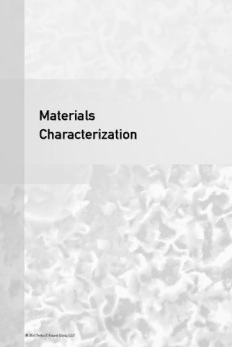Table Of ContentMaterials
Characterization
© 2016 Taylor & Francis Group, LLC
© 2016 Taylor & Francis Group, LLC
Pan Stanford Series on Renewable Energy — Volume 2
Materials
Characterization
Modern Methods and Applications
edited by
editors
Narayanaswami Ranganathan
Preben Maegaard
Anna Krenz
Wolfgang Palz
The Rise of Modern Wind Energy
Wind Power
for the World
© 2016 Taylor & Francis Group, LLC
CRC Press
Taylor & Francis Group
6000 Broken Sound Parkway NW, Suite 300
Boca Raton, FL 33487-2742
© 2016 by Taylor & Francis Group, LLC
CRC Press is an imprint of Taylor & Francis Group, an Informa business
No claim to original U.S. Government works
Version Date: 20151016
International Standard Book Number-13: 978-981-4613-07-1 (eBook - PDF)
This book contains information obtained from authentic and highly regarded sources. Reason-
able efforts have been made to publish reliable data and information, but the author and publisher
cannot assume responsibility for the validity of all materials or the consequences of their use. The
authors and publishers have attempted to trace the copyright holders of all material reproduced in
this publication and apologize to copyright holders if permission to publish in this form has not
been obtained. If any copyright material has not been acknowledged please write and let us know so
we may rectify in any future reprint.
Except as permitted under U.S. Copyright Law, no part of this book may be reprinted, reproduced,
transmitted, or utilized in any form by any electronic, mechanical, or other means, now known or
hereafter invented, including photocopying, microfilming, and recording, or in any information
storage or retrieval system, without written permission from the publishers.
For permission to photocopy or use material electronically from this work, please access www.
copyright.com (http://www.copyright.com/) or contact the Copyright Clearance Center, Inc.
(CCC), 222 Rosewood Drive, Danvers, MA 01923, 978-750-8400. CCC is a not-for-profit organiza-
tion that provides licenses and registration for a variety of users. For organizations that have been
granted a photocopy license by the CCC, a separate system of payment has been arranged.
Trademark Notice: Product or corporate names may be trademarks or registered trademarks, and
are used only for identification and explanation without intent to infringe.
Visit the Taylor & Francis Web site at
http://www.taylorandfrancis.com
and the CRC Press Web site at
http://www.crcpress.com
© 2016 Taylor & Francis Group, LLC
September2,2015 17:26 PSPBook-9inx6in 00–Ranganathan-prelims
Contents
Preface xiii
1 AdvancedNanomechanicalTestTechniques 1
BenD.Beake,AdrianJ.Harris,andTomaszW.Liskiewicz
1.1 Introduction 1
1.2 Nanoindentation 4
1.2.1 ContactMechanicsTheory 4
1.2.2 PracticalConsiderations 5
1.2.2.1 Referencematerialsforcalibration 5
1.2.2.2 Choiceofloadingramp 6
1.2.2.3 Instrumental(thermal)drift 7
1.2.2.4 Theinternationalstandardfor
depth-sensingindentation:ISO14577
parts1–4 7
1.2.2.5 Surfaceroughness 10
1.2.2.6 Determinationofframecompliance 10
1.2.2.7 Determinationoftheareafunction 12
1.2.2.8 Zero-pointcorrection 13
1.2.3 IndentationSizeEffects 14
1.2.4 ChoiceofIndenterGeometryandStress–Strain
Curves 16
1.2.5 PlasticityIndexandH/E 17
1.2.6 HardnessandElasticModulusofCoatings 18
1.2.7 UltrahardCoatings 19
1.2.8 DepthProfiling 20
1.2.9 MappingandPositioning 20
1.2.10FractureToughness 22
1.2.11MicropillarCompression,Microcantilever
Bending,andPush-OutTests 23
© 2016 Taylor & Francis Group, LLC
September2,2015 17:26 PSPBook-9inx6in 00–Ranganathan-prelims
vi Contents
1.2.11.1Micropillarcompression 24
1.2.11.2Microcantilevers 24
1.2.11.3Fiberpush-out 26
1.3 Nanotribology(NanoscratchandWear) 27
1.3.1 CriticalLoadSensitivitytoIntrinsicand
ExtrinsicFactors 28
1.3.2 Topography-ProgressiveLoad
Scratch-TopographyMultipassScratchTests 29
1.3.3 InfluenceofProbeRadiusandGeometry 30
1.3.4 ContactPressure 32
1.3.5 InfluenceofFilmStressandThickness 33
1.3.6 RepetitiveNanowear 35
1.3.7 SurfaceRoughness 36
1.3.8 Friction 37
1.4 Nanofretting 38
1.4.1 FrettingDamage 39
1.4.2 Small-ScaleFretting 42
1.4.3 Indentation,Scratch,andSmall-ScaleFretting
onSi 45
1.4.4 Small-ScaleFrettingofta-CFilmsonSi 47
1.4.5 Small-ScaleFrettingofBiomedicalMaterials 48
1.5 Nanoimpact 49
1.5.1 Single-ImpactTests 50
1.5.2 Repetitive-ImpactTests 51
1.6 EnvironmentalConsiderations(Hot,Cold,Fluid,
Humidity) 58
1.6.1 InfluenceofMoistureandElectrochemical
PotentialonNanoindentationBehavior 58
1.6.2 NanoscratchandNanoimpactTestinginLiquid 62
1.6.3 MeasuringHigh-TemperatureMechanical
PropertiesbyNanoindentation 63
1.6.3.1 Tribochemicalinteractionsbetween
indenterandsample 67
1.6.3.2 (Ti,Al)Ncoatingsforcuttingtools:
Roleofannealingat700◦C–900◦C 69
1.6.3.3 Fuelcellmaterials 72
1.6.4 Nonambient-TemperatureNanoscratchand
NanoimpactTesting 73
© 2016 Taylor & Francis Group, LLC
September2,2015 17:26 PSPBook-9inx6in 00–Ranganathan-prelims
Contents vii
1.6.4.1 High-temperaturenanoscratchand
frictiontesting 73
1.6.4.2 Subambient-temperature
nanoindentation,nanoscratch,and
nanoweartesting 76
1.6.4.3 High-temperaturenanoimpacttesting 77
1.7 SummaryandOutlook 77
2 SurfacePropertiesofPolymersandRubberMeasuredby
Nanoindentation 91
DariuszM.Bielin´ski
2.1 Introduction 91
2.2 Experiments 93
2.2.1 Instrumentation 93
2.2.2 Methodology 94
2.2.2.1 Nanoindentation 94
2.2.2.2 Creep 95
2.2.2.3 Bloomthickness 95
2.3 ResultsandDiscussion 96
2.3.1 SurfaceGradientofCrosslinksinRubber
Vulcanizates 96
2.3.2 SurfaceSegregationinPolymerBlends 99
2.3.3 PhysicalandChemicalModificationofthe
SurfaceLayerofPolymers 101
2.3.4 PhotopolymerizationofPolyesterResin 107
2.3.5 AgingofPolymerMaterials 108
2.3.6 SurfaceGradientofRubberVulcanizate
Crosslinks 110
2.4 SummaryandConclusions 112
3 CharacterizationofLight-CuredDentalComposites 117
JoannaKleczewska,DariuszM.Bielin´ski,
NarayanaswamiRanganathan,andJerzySokolowski
3.1 Introduction 117
3.1.1 ChemistryofDentalComposites(Yesterday
andToday) 118
3.1.1.1 Matrix 118
3.1.1.2 Fillers 122
© 2016 Taylor & Francis Group, LLC
September2,2015 17:26 PSPBook-9inx6in 00–Ranganathan-prelims
viii Contents
3.1.2 Photopolymerization:GradientofMorphology
andProperties 123
3.2 ConventionalMethodsofCharacterizationof
MechanicalPropertiesofDentalComposites 125
3.2.1 MicrohardnessTests 125
3.2.2 Three-PointBendingTest:TheOnlyTestof
MechanicalPropertiesIncludedinPN-ENISO
4049Standard 127
3.2.3 LimitationofConventionalTests 127
3.3 NovelApproachtoDentalCompositeCharacterization 129
3.3.1 PropertiesoftheSurfaceLayer:
NanoindentationTests 129
3.3.2 TribologicalExperiments 131
3.3.3 FractureToughnessofDentalFillings 134
3.3.4 PositronAnnihilationLifetimeSpectroscopy 137
3.4 Summary 143
4 PropertiesofaLead-FreeSolder 149
ZeMa,FlorentChalon,Rene´ Leroy,DenisBertheau,
andNaryanaswamiRanganathan
4.1 Introduction 149
4.1.1 GlobalPropertiesbyConventionalTests 150
4.1.2 LocalProperties 152
4.2 FatigueBehavior 155
4.2.1 GlobalFatigueBehavior:PredeformationEffect
onFatigue 157
4.2.2 AnalysisofHysteresisBehavior 157
4.2.3 FatigueLifeCurvesandFractography 166
4.3 LocalFatigueBehavior 168
4.4 SummaryandConclusions 171
5 DeterminationofPlasticZoneSizesattheCrackTip 175
TienDungDo,FlorentChalon,Rene´ Leroy,DamienJoly,
andNaryanaswamiRanganathan
5.1 Introduction 175
5.2 DefinitionoftheFatiguePlasticZoneattheCrackTip 176
5.3 CurrentTechniquesforEstimatingandMeasuringthe
FatiguePlasticZoneattheCrackTip 178
© 2016 Taylor & Francis Group, LLC
September2,2015 17:26 PSPBook-9inx6in 00–Ranganathan-prelims
Contents ix
5.3.1 MicrohardnessMeasurement 178
5.3.2 EtchingofthePlasticZone 179
5.3.3 OpticalInterferenceTechnique 179
5.3.4 FoilStrain-GaugeTechnique 180
5.3.5 RecrystallizationMethod 181
5.3.6 X-RayMicrobeamTechnique 181
5.3.7 ShearLipSizeMeasurements 182
5.3.8 Selected-AreaChannelingPatternTechnique 182
5.3.9 SlipLinesMethod 183
5.4 MeasuringthePlasticZoneSizeattheFatigueCrack
TipbyNanoindentationTechnique 183
5.4.1 IntroductiontotheNanoTestSystem 183
5.4.2 FatigueCrackGrowthTest 186
5.4.3 NanoTest 188
5.4.4 ExperimentalResultsandAnalysis 189
5.5 EstimationofStraininthePlasticZone 191
5.6 Conclusions 194
6 MultipleAspectsofPolychloroprene’sFatigueBehavior 199
J.L.Poisson,S.Meo,F.Lacroix,G.Berton,
andN.Ranganathan
6.1 Introduction 199
6.2 PolychloropreneFatigue-DamagingFeatures 202
6.3 PolychloropreneFatigueBehavior 208
6.3.1 UniaxialFatigue 208
6.3.2 MuliaxialFatigue 213
6.4 Conclusion 219
7 FatigueCrackGrowthRateMeasurement:AReview 225
PeterC.McKeighan
7.1 Introduction 226
7.2 PreliminaryDetails:DevelopingaTestingPlan 226
7.3 CrackLengthMeasurement 231
7.3.1 Compliance 232
7.3.2 DCPotentialDrop 234
7.3.3 OtherMethods 236
7.4 TestingStandards 238
7.5 FCGTestingMethods:da/dNversus(cid:2)K 239
© 2016 Taylor & Francis Group, LLC
September2,2015 17:26 PSPBook-9inx6in 00–Ranganathan-prelims
x Contents
7.5.1 Precracking 240
7.5.2 LoadControlduringFCGTesting 240
7.5.3 CrackGrowthRateDataAnalysis 242
7.5.4 FatigueCrackGrowthRateVariability 244
7.6 FCGTestingMethods:VariableLoadAmplitude 246
7.6.1 EssenceofaSpectrumCrackGrowthCoupon
Test 246
7.6.2 TestProgramDetail 247
7.7 OtherMiscellaneousIssues 250
7.7.1 TestinginanEnvironment 250
7.7.2 TestingwithResidualStresses 252
7.7.3 TestingwithWelds 254
8 MeasurementofWearandFrictionResistanceofBulkand
CoatedMaterials 259
CarolineRichard,GeethaManivasagam,andYanMingChen
8.1 Introduction 259
8.2 ElementsofTribologicalTesting 260
8.2.1 EconomicImportanceandTechnological
Particularities 260
8.2.2 ObjectivesandClassificationofTribological
Tests 261
8.2.3 StateoftheArtoftheTribometers 267
8.2.4 MethodsofPresentationofTribologicalResults 271
8.2.4.1 Temporaldependenceoftribological
data 272
8.2.4.2 Dependenceoftribologicaldata
comparedtoinputparameters 275
8.2.4.3 Wearmap 276
8.2.4.4 Transitiondiagram 277
8.3 SpecificTribologicalMeasurements:Exampleof
Biomaterials(withandwithoutSurfaceTreatments) 279
9 ElasticPropertiesCharacterizationbyMeansofDynamic
ResonantTechnique 289
PascalGadaud
9.1 Introduction 290
9.2 ElastictyofBulkMaterials 290
© 2016 Taylor & Francis Group, LLC

